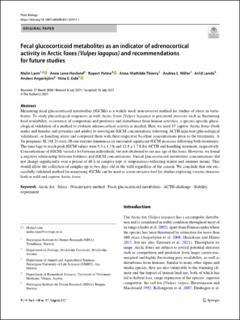| dc.contributor.author | Larm, Malin | |
| dc.contributor.author | Hovland, Anne Lene | |
| dc.contributor.author | Palme, Rupert | |
| dc.contributor.author | Thierry, Anne-Mathilde | |
| dc.contributor.author | Miller, Andrea | |
| dc.contributor.author | Landa, Arild | |
| dc.contributor.author | Angerbjörn, Anders | |
| dc.contributor.author | Eide, Nina Elisabeth | |
| dc.date.accessioned | 2022-11-02T12:03:21Z | |
| dc.date.available | 2022-11-02T12:03:21Z | |
| dc.date.created | 2021-08-25T10:05:21Z | |
| dc.date.issued | 2021 | |
| dc.identifier.issn | 0722-4060 | |
| dc.identifier.uri | https://hdl.handle.net/11250/3029585 | |
| dc.description.abstract | Measuring fecal glucocorticoid metabolites (fGCMs) is a widely used, non-invasive method for studies of stress in vertebrates. To study physiological responses in wild Arctic foxes (Vulpes lagopus) to perceived stressors such as fluctuating food availability, occurrence of competitors and predators and disturbance from human activities, a species-specific physiological validation of a method to evaluate adrenocortical activity is needed. Here we used 15 captive Arctic foxes (both males and females and juveniles and adults) to investigate fGCM concentrations following ACTH injection (physiological validation), or handling alone and compared them with their respective baseline concentrations prior to the treatments. A 5α-pregnane-3ß,11ß,21-triol-20-one enzyme immunoassay measured significant fGCM increases following both treatments. The time lags to reach peak fGCM values were 9.3 ± 1.3 h and 12.8 ± 1.7 h for ACTH and handling treatment, respectively. Concentrations of fGCMs varied a lot between individuals, but not attributed to sex nor age of the foxes. However, we found a negative relationship between boldness and fGCM concentrations. Faecal glucocorticoid metabolites concentrations did not change significantly over a period of 48 h in samples kept at temperatures reflecting winter and summer means. This would allow the collection of samples up to two days old in the wild regardless of the season. We conclude that our successfully validated method for measuring fGCMs can be used as a non-invasive tool for studies exploring various stressors both in wild and captive Arctic foxes. | en_US |
| dc.language.iso | eng | en_US |
| dc.rights | Navngivelse 4.0 Internasjonal | * |
| dc.rights.uri | http://creativecommons.org/licenses/by/4.0/deed.no | * |
| dc.subject | Stress | en_US |
| dc.subject | Stress | en_US |
| dc.subject | Fjellrev | en_US |
| dc.subject | Arctic fox | en_US |
| dc.title | Fecal glucocorticoid metabolites as an indicator of adrenocortical activity in Arctic foxes (Vulpes lagopus) and recommendations for future studies | en_US |
| dc.type | Peer reviewed | en_US |
| dc.type | Journal article | en_US |
| dc.description.version | publishedVersion | en_US |
| dc.subject.nsi | VDP::Matematikk og Naturvitenskap: 400 | en_US |
| dc.source.journal | Polar Biology | en_US |
| dc.identifier.doi | 10.1007/s00300-021-02917-1 | |
| dc.identifier.cristin | 1928580 | |
| cristin.ispublished | true | |
| cristin.fulltext | original | |
| cristin.qualitycode | 1 | |

